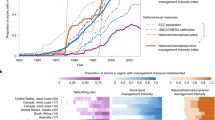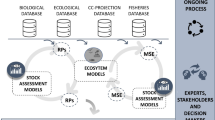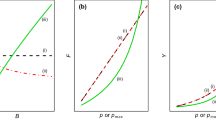Abstract
Single-stock management dominates the international regulation of marine fisheries. Indeed, the maximum sustainable yield (MSY) rubric is used in 10 of 16 marine regional fisheries management organizations (RFMOs). Early on, MSY was the best, and often only, scientific benchmark available. Now, scientists know much more about ecosystem interactions and have the tools to implement multi-species management, but RFMOs continue to manage stocks and species separately. This article explores the reasons for this continuity and the potential for change in the system. In it, I propose that a focus on allocation rather than conservation generates preferences for MSY over the lower, more precautionary, catch limits that would result from an ecosystem approach. I test this hypothesis using RFMO data. I then move on to discuss the results and propose that strategic considerations should be taken into account when advocating for ecosystem-based management.



Similar content being viewed by others
Notes
There are also the 2001 Reykjavik Declaration on Responsible Fisheries in the Marine Ecosystem, which mandates EBM again, and the 2003 FAO Technical Guidelines on the Implementation of the Ecosystem Approach to Fisheries Management.
Methodological advances include the Ecosim and Ecopath modeling package (Christensen and Walters 2004; Polovina et al. 2009), the Spatial Ecosystem and Population Dynamics Model (SEAPODYM) for Indo-Pacific tuna fisheries in Lehody et al. (2010), a similar model for the Atlantic, Apex Predators Ecosystem Model (APECOSM) (Maury 2010), and various general approaches (see, i.e., Smith et al. 2007; Stafford 2008; Samhouri et al. 2010).
Apologies for the alphabet soup. It seems to be unavoidable when dealing with international fisheries.
Hypothetically, some EBM approaches could lead to higher sustainable harvests than single-species management (i.e., marine protected areas with substantial impacts on aggregate MSY). In such cases, we might even see allocation organizations favoring EBM. However, evidence that EBM can increase harvests over MSY management is limited, and in most cases, we would expect lower yields, particularly of high-value species, with EBM.
While I recognize that there is considerable contestation over what constitutes ecosystem-based fisheries management, my goal is to cast the widest net possible and present all the evidence so that readers can decide for themselves.
Environmental changes refer to shifts in environmental conditions such as temperature gradients, nutrient availability, and primary production. Trophic interactions refer to changes in the trophic system due to removal of key species. For instance, overfishing cod on the Grand Banks may have altered the trophic structure such that crustaceans (crab, shrimp) and pinnipeds (seals, sea lions) now dominate instead of groundfish.
Data on IUU fishing are lacking, but what evidence there is suggests that IUU catches may be equal to legal catches for highly valued species like bluefin tuna, Antarctic toothfish, and orange roughy.
This is mainly used against nonmembers either because members can block consensus or, where majority voting is possible, because members fear setting a precedent.
http://www.fao.org/fishery/rfb/search/en; there are 28 RFMOs with only advisory or nonmanagement authority on the FAO's lists. There are three marine management RFMOs with little or no history to evaluate (RECOFI, SORFMO, and SIOFA) and two inland RFMOs with management capacity (CACFAC and LVFO) which were not included in this study. RFMOs covering anadromous species are included in the study.
People usually only refer to tuna and tuna-like species (marlin, swordfish, etc.) as highly migratory species. However, whale migrations are extensive, and both CCAMLR and the GFCM cover an entire ocean/sea. Although SEAFO is mainly responsible for straddling stocks, it should also be noted that this commission covers discrete (not highly migratory) high seas stocks within its management area (Jackson 2002).
“Scientific” harvests by Japan and commercial harvests by Norway continued during the ban. In 1994, the IWC adopted Revised Management Procedures that should hypothetically allow a return to commercial whaling of healthy stocks, but this has not yet occurred (Kock 2007, p. 235–236). Japanese attempts to restart their fishery were stymied by radical conservationist tactics in 2011.
This was also a response the US declaration of a 200-mile conservation zone through the Truman Declaration that was designed to protect Alaska fisheries from exploitation by the Japanese and others (Juda 1996, pp. 114–115).
For sharks: require that fins are limited to 5 % of the catch; for turtles and seabirds, encourage avoidance through gear modifications and live release when captured.
More on this when I cover the HMS RFMOs later in this section.
HMS RFMOs do not manage groundfish species or deal with deepwater trawls. Oceanic RFMOs do.
In a study of the implementation of EBM in 33 countries, Pitcher et al. (2009) find that most countries, especially several European countries, have not really succeeded in using an ecosystem approach to fisheries management domestically. In contrast, the USA and Canada have done quite well implementing EBM within their EEZs.
Basic texts were not available for the IPHC, which went into force in 1923. However, recent versions of the agreement including amendments through 2003 were included in the search.
Pers. Obs. FAO Expert Consultation of the Regional Fisheries Management Bodies on the Harmonization of Catch Certification, May 2002, La Jolla, California.
See also Babcock and Pikitch (2004) on the impracticality of using marine protected areas as the only mechanisms of ecosystem-based management.
Powers and Monk (2010) reach similar conclusions about domestic implementation of EBM.
References
Babcock EA, Pikitch EK (2004) Can we reach agreement on a standardized approach to ecosystem-based fishery management? Bull Mar Sci 74(3):685–692
Baird R (2004) Illegal, unreported and unregulated fishing: an analysis of the legal, economic and historical factors relevant to its development and persistence. Melb J Int Law 5(2):299–334
Bjørndal T (2009) Overview, roles, and performance of the north east Atlantic fisheries commission (NEAFC). Mar Policy 33(4):685–697
Browman HI, Stergiou KI (2005) Politics and socio-economics of ecosystem-based management of marine resources, introduction. Mar Ecol Prog Ser 300:241–296
Charbonnier D (1977) Prospects for fisheries in the Mediterranean. Ambio 6(6):374–376
Christensen V, Walters CJ (2004) Ecopath with Ecosim: methods, capabilities and limitations. Ecol Model 172(2–4):109–139
Cochrane K (1999) Complexity in fisheries and limitations in the increasing complexity of fisheries management. ICES J Mar Sci 56(6):917–926
Crowder LB, Avissar N, Bjorkland R, Hazen EL, Latanich C, Ogburn MB (2008) The impacts of fisheries on marine ecosystems and the transition to ecosystem-based management. Annu Rev Ecol Evol Syst 39:259–278
Dame JK, Christian RR (2006) Uncertainty and the use of network analysis for ecosystem-based fishery management. Fisheries 31(7):331–341
DeSombre ER (1999) Tuna fishing and common pool resources. In: Barkin JS, Shambaugh GE (eds) Anarchy and the environment. State University of New York Press, New York, pp 51–67
Dunlap WV (1995) Bering Sea. Int J Mar Coast Law 10(1):114–135
FAO (2003) The ecosystem approach to fisheries management. UN Food and Agriculture Organization, Rome. http://www.fao.org/fishery/topic/13261/en. Accessed March 6, 2011
FAO (2009) The state of world fisheries and aquaculture 2008. UN Food and Agriculture Organization, Rome
Finley C (2009) The social construction of fishing, 1949. Ecol Soc 14(1)
Frid CL, Catherine J, Scott L, Odette A, Paramor L (2006) Ecosystem-based management of fisheries: is science limiting? ICES J Mar Sci 63(9):1567–1572
ICES (2009) Report on the Meeting Between ICES and Client Commissions (MICC). International Council for the Exploration of the Seas, Copenhagen
Jackson A (2002) The convention on the conservation and management of fishery resources in the South East Atlantic Ocean, 2001: an introduction. Int J Mar Coast Law 17(1):33–77
Juda L (1996) International law and ocean use management: the evolution of ocean governance. Routledge, New York
Kock K-H (2007) Antarctic marine living resources—exploitation and its management in the Southern Ocean. Antarct Sci 19(2):231–238
Lehodey P, Senina I, Sibert J, Bopp L, Calmettes B, Hampton J, Murtugudde R (2010) Preliminary forecasts of pacific bigeye tuna population trends under the A2 IPCC scenario. Prog Oceanogr 86(1–2):302–315
Levin PS, Samhouri JF, Ainsworth CH (2010) Identifying thresholds for ecosystem-based management. PLoS One 5(1)
Marasco RJ, Goodman D, Grimes CB, Lawson PW, Punt AE, Quinn TJ II (2007) Ecosystem-based fisheries management: some practical suggestions. Can J Fish Aquat Sci 64(6):928–939
Maury O (2010) An overview of APECOSM, a spatialized mass balanced “apex predators ECOSystem model” to study physiologically structured tuna population dynamics in their ecosystem. Prog Oceanogr 84(1–2):113–117
Miller KA (1996) Salmon stock variability and the political economy of the Pacific Salmon Treaty. Contemp Econ Policy 14(3):112–129
Monk MH, Powers JE (2010) Current and future use of indicators for ecosystem based fisheries management. Mar Policy 34(3):723–727
NOAA (2010) Large marine ecosystems of the world. http://www.lme.noaa.gov/LMEWeb/downloads/lme64.pdf. Accessed March 6, 2011)
Parris H (2010) Is the Western and Central Pacific Fisheries Commission meeting its conservation and management objectives? Ocean Coast Manag 53(1):10–26
Peterson MJ (1995) International fisheries management. In: Haas PM, Keohane RO, Levy MA (eds) Institutions for the earth. MIT Press, Cambridge, pp 249–305
Pitcher TJ, Kalikoski D, Short K, Varkey D, Pramod G (2009) An evaluation of progress in implementing ecosystem-based management of fisheries in 33 countries. Mar Policy 33(2):223–232
Polovina JI, Abecassis M, Howell EA, Woodworth P (2009) Increases in the relative abundance of mid-trophic level fishes concurrent with declines in apex predators in the subtropical North Pacific, 1996–2006. Fish Bull 107(4):523
Potter ECE, MacLean JC, Wyatt RJ, Campbell RNB (2003) Managing the exploitation of migratory salmonids. Fish Res 62(2):127–142
Rudd M (2004) An institutional framework for designing and monitoring ecosystem-based fisheries management policy experiments. Ecol Econ 48(1):109–124
SEAFO (2009) Report of the SEAFO scientific committee. Walvis Bay, Namibia: South East Atlantic Fisheries Organization
Smith DC, Smith ADM, Hobday AJ, Shoulder P, Fulton EJ (2007) Scientific tools to support the practical implementation of ecosystem-based fisheries management. ICES J Mar Sci 64(4):633–639
Stafford R (2008) A computational approach to ecological and economic sustainable harvest management strategies in a multi-species context, with implications for cod recovery plans. Ecol Informa 3(1):105–110
Torell M (2009) Some institutional implications of an ecosystems approach to capture fisheries management. Aquat Ecosyst Heal Manag 12(4):440–443
Webber ML (2002) From abundance to scarcity. Island Press, Washington
Webster DG (2009) Adaptive governance: the dynamics of Atlantic fisheries management. MIT Press, Cambridge
Author information
Authors and Affiliations
Corresponding author
Additional information
This paper only covers “international” fisheries—those that take place in multiple EEZs and/or on the high seas.
Rights and permissions
About this article
Cite this article
Webster, D.G. International fisheries: assessing the potential for ecosystem management. J Environ Stud Sci 3, 169–183 (2013). https://doi.org/10.1007/s13412-013-0123-2
Published:
Issue Date:
DOI: https://doi.org/10.1007/s13412-013-0123-2




